Expert Advice
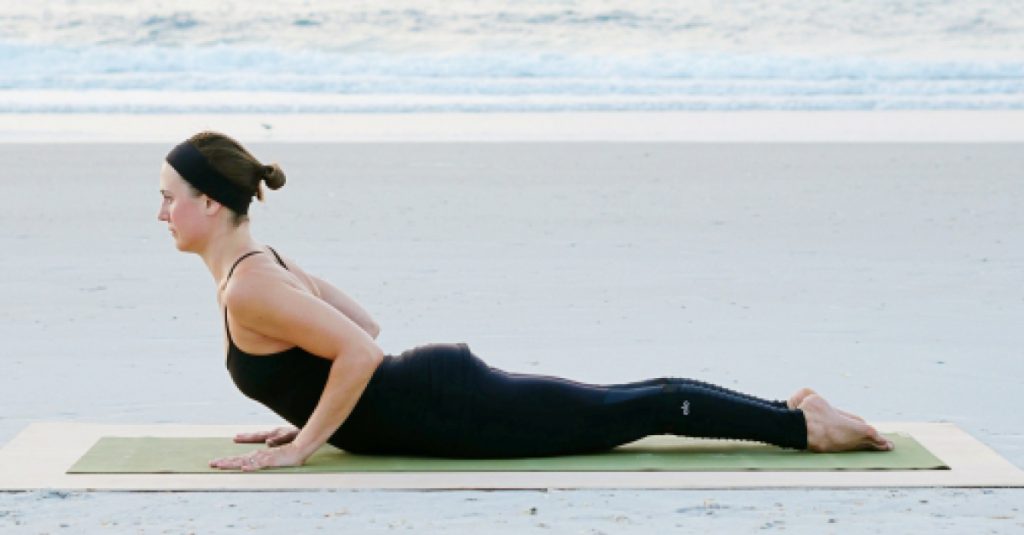
Acella Pharmaceuticals, LLC., is partnering with Lexi Hawks, an E-RYT 500 Hr Yoga Alliance Certified Teacher, to bring greater awareness to the importance of thyroid care and education. This post was sponsored by Acella Pharmaceuticals and should not be construed as medical advice. Please talk to your doctor about your individual medical situation.
Disclaimer: The information provided is for educational purposes only and does not substitute professional medical advice. Consult a medical professional or healthcare provider before beginning any exercise, fitness, diet, or nutrition routine. Acella Pharmaceuticals, LLC does not endorse, promote or sponsor any products or brands mentioned in this article. The views expressed here are those of the author.
The New Year is a time we tend to evaluate our lives and either recommit to or set new personal goals. Typically, health goals are high on the list. A regular practice of yoga postures and breathing may help relieve stress, improve balance, and build strength.
In this post, I review some beginner yoga postures perfect for those who are looking to embark on yoga in the New Year. This year, set a new goal to improve your health and wellness with a beginner yoga practice. Read below to learn five yoga postures to jump-start your New Year for a happier, healthier you!
1. Mountain Pose (Tadasana)
Many of us might think we know how to stand; after all, this is something that most people do every day. However, stance and balance is critical to understanding yoga postures and will help bring more balance into your everyday movement.
Start with your feet hip distance apart and parallel. Look and see that the toes are pointed forward and heels are aligned with the toes. Allow your weight to descend through the heels as you draw the upper thighs over the ankles. Lift the toes and spread them wide to feel the inner arches of the feet activate. Send this lift of the inner arch all the way up your leg. Energetically lift the front of the ankles, shin bones, knees and thighs. The leg will engage to be totally straight and strong. Maintain the grounded heels as you lower the toes down to the floor, keeping the toes wide and long. Draw this uplifted energy into the trunk and reach the sides of the torso upward, widen the collar bones and draw the outer shoulder back to feel the shoulder blades move toward each other. Lengthen the neck and extend all the way through the crown of the head. Reach the arms long and straight next to the sides of the truck. Feel the elbows straighten and each finger pull downward in length.
Hold the pose while feeling the strength and grounded energy of a majestic mountain. Allow the breath to move in and out of the body through the nose. Let the breath be slow so that you feel the chest expand in all directions with your inhale and contract with each exhale. Can the inhale grow your mountain pose a little taller and each exhale ground and strengthen the pose a little more?
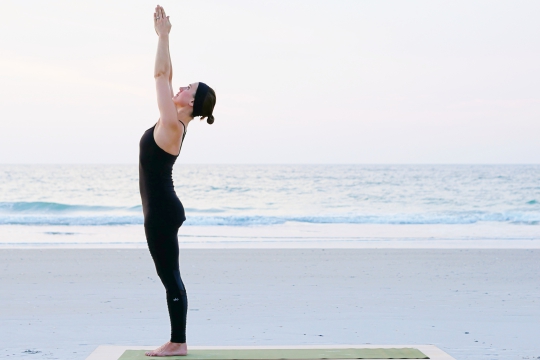
2. Upward Salute (Urdhva Hastasana)
While maintaining mountain pose, start with the palms of your hands facing the sides of your thighs. Roll the inner arm toward the outer arm (external rotation) and reach the arms out and up overhead. Allow the arms to pull and lengthen from the center of the chest. Pause with the arms reaching overhead. If the shoulders feel tight or lifted toward the ears, widen the arms and allow for the shoulders to drop away from the ears. Extend the arms with effort and energy. Let the gaze of your eyes move to your hands.
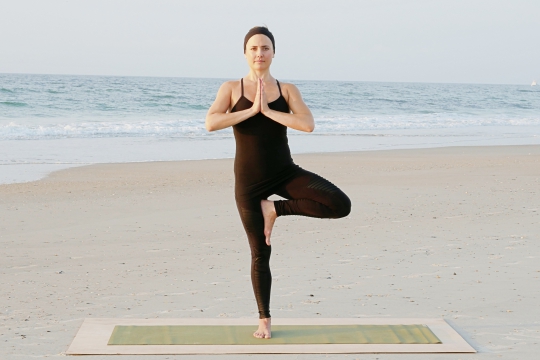
3. Tree Pose (Vrikshasana)
From mountain pose, shift the weight of your body to the right foot. Turn the left leg out to the left (external rotation through the left hip joint) and place the left heel on the right inner ankle bone. Keep the ball of the left foot on the ground. Press the heel and the inner ankle bone together and allow this motion to center the body weight, engage the leg muscles, and balance the hips. If your balance feels stable here, challenge yourself by drawing the left sole of the foot onto the inner right calf. Press the sole of the foot firmly to the inner right calf. If your balance still feels solid, further challenge yourself by drawing the sole of the left foot above the right knee. Reach down with your left hand and grab the ankle of your left foot. Draw the foot high and place the left heel on the upper right thigh, just below the groin. Press the sole of the left foot firmly to the thigh muscle and counter-press the thigh back into the sole of the foot.
If your balance feels challenging, place the hands on the back of chair or on a wall for added support. If your balance feels solid, try placing the hands on the hips or pressing the palms together at the center of the chest. If you feel well-balanced, try taking the arms over the head. Let the breath remain full in this pose and take a moment of gratitude when breathing deeply into the chest.
Repeat this pose on the other leg.
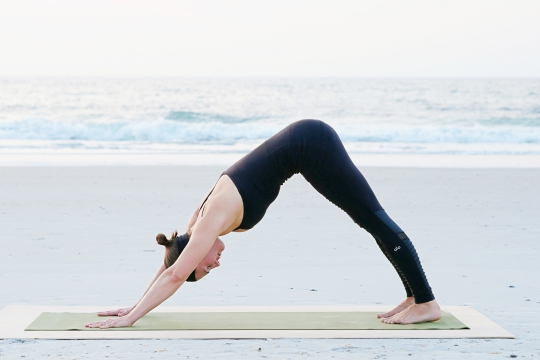
4. Downward Facing Dog (Adho Mukha Svanasana)
Downward facing dog is an inverted V shape. For many people with tight shoulders or wrists, or those unable to place pressure on the hands, it will be best to modify this pose by doing it with your hands on a wall. Otherwise, start in a tabletop pose, walk your hands slightly ahead of your shoulders and shoulder distance apart. Press through the four corners of the palms and root the hands firmly to the ground. Press the hands down and forward to elongate the arms while tucking the toes under and lifting the hips up then back. For tension in the back of the legs and back, try taking your feet wide and lifting your heels. Let the head stay relaxed and the breath full.
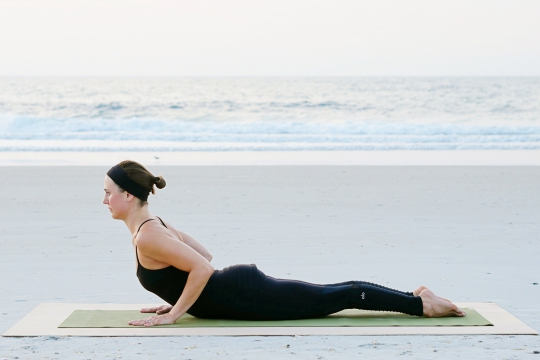
5. Cobra Pose (Bhujangasana)
Lay down on your belly with your forehead centered and resting on the floor. Bend your elbows toward the ceiling and slide the palms of your hands back near the middle of the ribcage. Be sure the hands maintain shoulder distance space. The legs can be hip distance or slightly closer together. Allow both legs to stretch straight and long behind you, from the root of the hip all the way through the toes. Pressurize the palms down to the floor and energetically pull them back to help elongate the sides of the torso. With an inhale, draw the chest forward and up. Keep the legs reaching back. Try to pull space along the spine to extend the back in the forward and up motion, as the legs ground down and back. Let the inhales spread the upper chest wide and feel the uplifting energy enter the body.
Give yourself the opportunity to try these yoga poses over and over. Keep a sense of inquiry and investigation. Notice what you feel like before the pose, in the pose and after the pose. Perhaps even just a few yoga poses every day will help deepen your breath, center your focus and help release a little stress. Namaste!
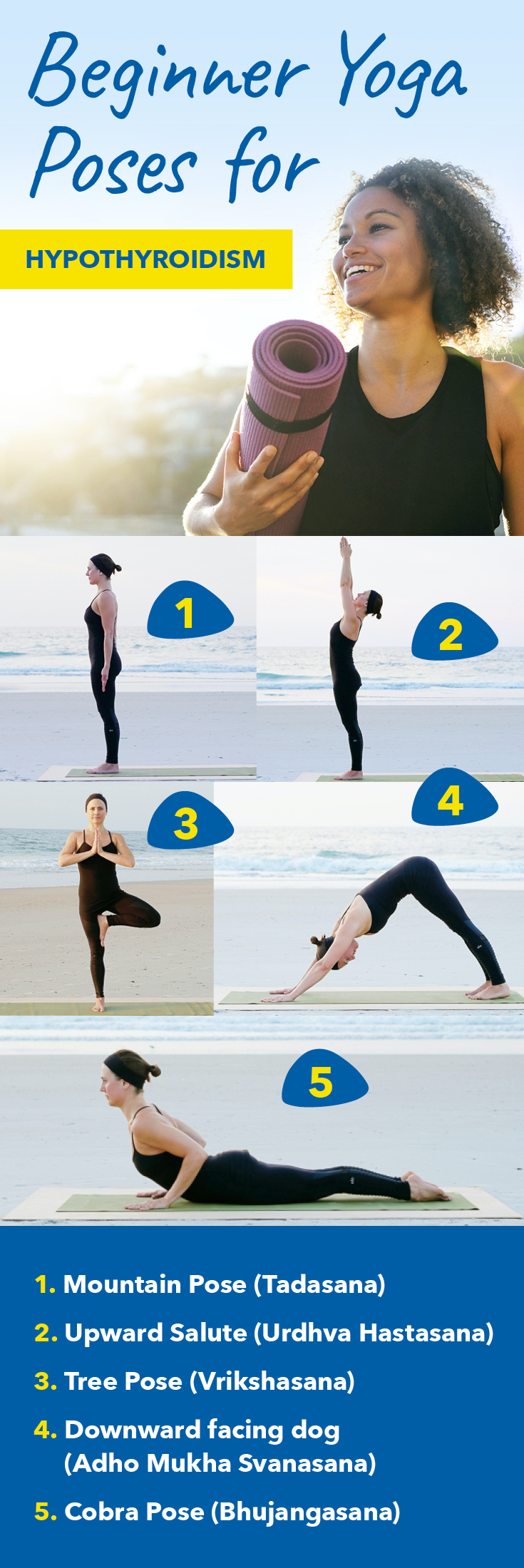
Note that DTE products, including NP Thyroid®, have not been reviewed by the FDA for safety or efficacy.
IMPORTANT RISK INFORMATION, INCLUDING BOXED WARNING & INDICATIONS
Important Risk Information
Drugs with thyroid hormone activity, alone or together with other therapeutic agents, have been used for the treatment of obesity. In euthyroid patients, doses within the range of daily hormonal requirements are ineffective for weight reduction. Larger doses may produce serious or even life-threatening manifestations of toxicity, particularly when given in association with sympathomimetic amines such as those used for their anorectic effects.
- NP Thyroid® is contraindicated in patients with uncorrected adrenal insufficiency, untreated thyrotoxicosis, and hypersensitivity to any component of the product.
- In the elderly and in patients with cardiovascular disease, NP Thyroid® should be used with greater caution than younger patients or those without cardiovascular disease.
- Use of NP Thyroid® in patients with diabetes mellitus or adrenal cortical insufficiency may worsen the intensity of their symptoms.
- The therapy of myxedema coma requires simultaneous administration of glucocorticoids.
- Concomitant use of NP Thyroid® with oral anticoagulants alters the sensitivity of oral anticoagulants. Prothrombin time should be closely monitored in thyroid-treated patients on oral anticoagulants.
- In infants, excessive doses of NP Thyroid® may produce craniosynostosis.
- Partial loss of hair may be experienced by children in the first few months of therapy but is usually transient.
- Adverse reactions associated with NP Thyroid® therapy are primarily those of hyperthyroidism due to therapeutic overdosage.
- Many drugs and some laboratory tests may alter the therapeutic response to NP Thyroid ®. In addition, thyroid hormones and thyroid status have varied effects on the pharmacokinetics and actions of other drugs. Administer at least 4 hours before or after drugs that are known to interfere with absorption. Evaluate the need for dose adjustments when regularly administering within one hour of certain foods that may affect absorption.
- NP Thyroid® should not be discontinued during pregnancy, and hypothyroidism diagnosed during pregnancy should be promptly treated.
Indications
NP Thyroid® (thyroid tablets, USP) is a prescription medicine that is used to treat a condition called hypothyroidism from any cause, except for cases of temporary hypothyroidism, which is usually associated with an inflammation of the thyroid (thyroiditis). It is meant to replace or supplement a hormone that is usually made by your thyroid gland.
NP Thyroid® is also used in the treatment and prevention of normal functioning thyroid goiters, such as thyroid nodules, Hashimoto’s thyroiditis, multinodular goiter, and in the management of thyroid cancer.
Revised
10/2023
You Are About To Leave This Website
By clicking continue, this link will take you to a website to which Alora Pharmaceuticals’ Policies & Terms of Use do not apply.
^Based on prescriptions filled, NP Thyroid® is the #1 Prescribed DTE in the United States. Source: IQVIA National Prescription Audit (NPA) data on file. Acella Pharmaceuticals, LLC.
